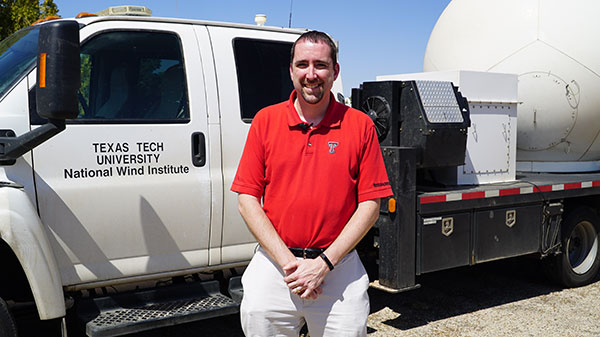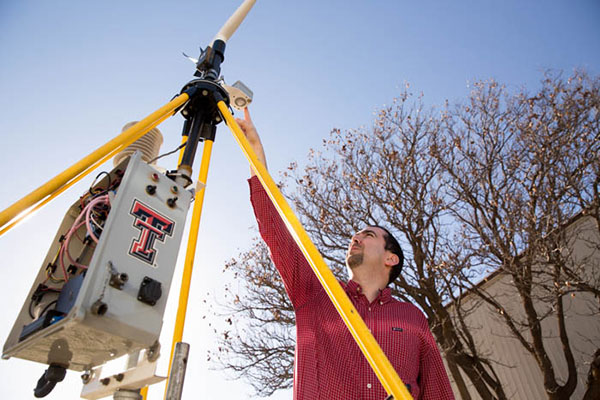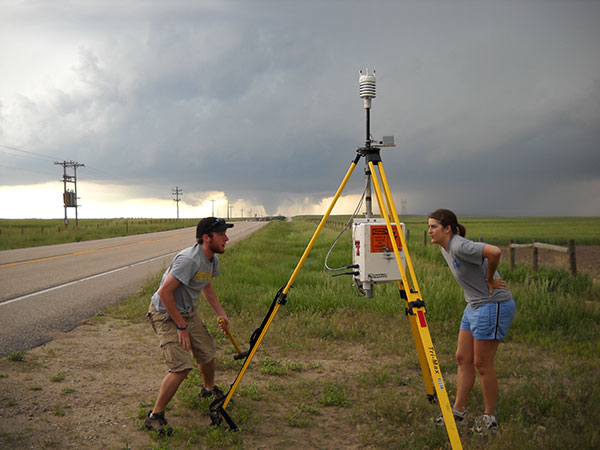Understanding Tornadoes
By: Sally Logue Post
Texas Tech researchers are working to find the best ways to predict deadly tornadoes
Chasing storms is serious business – sometimes it's seriously dangerous. Storm chasers want to get close enough to see the storm, while staying far enough away for safety.
Some storm chasers are working in the moment to help make determinations about the severity of an approaching storm to better warn the people in its path. Others, like Texas Tech's Christopher Weiss, have a more long-term game plan they are trying to better understand how tornadoes form.
Tornadoes are deadly and destructive. The National Weather Service (NWS) reports that nationally tornadoes killed 36 people and injured 924 in 2015. The storms caused almost $268 million dollars in damaged property and crops.
Better understanding of how tornadoes develop inside a thunderstorm is an important part of helping the NWS better warn of an impending danger.
Weiss, an associate professor of atmospheric science, and his colleagues at Texas Tech are working on two fronts this spring using drones and more traditional measurement tools to learn better how to predict the unpredictable.

Why the Southeast?
Weiss and his team are spending two months in the Southeastern U.S., primarily based in northern Alabama, looking at how and why tornadoes form in that part of the country. Texas Tech is one of several universities participating in VORTEX-SE or the Verification of the Origins of Rotation in Tornadoes Experiment-Southeast. The project looks not only at the conditions that produce storms, but also how the weather service predicts and warns the public about storms.

This is the second year of the congressionally mandated project initiated after a severe tornado outbreak in the region in 2011. NWS statistics show that Alabama was particularly hit hard with 145 tornadoes touching, more than twice the 10 year average for tornadoes in the state. Those 2011 storms killed 242 people and injured 2,113. Of the 145 tornadoes, 109 occurred in April.
While some researchers believe that an area's environment and terrain might affect the development of tornadoes, there is not a lot of information collected to verify that theory.
"The Southeast has fewer tornadoes than we see in Texas," Weiss said. "But it seems the tornadoes that do develop are deadlier. We don't know if that is from a lack of visibility because the area is heavily wooded and mountainous or if they are coming out of storms that have lower predictability of producing tornadoes."
Texas Tech's Contribution
Texas Tech's four-person team is contributing three elements to the project: a mobile sounding unit that can measure humidity and temperature in the atmosphere; portable lightning mapping array stations and mobile StickNets, 24 student-developed observation stations.
Developed in 2005 by Texas Tech students, the platforms were named StickNets for their resemblance to a stick figure. The mobile devices can be quickly set up by two people and can measure temperature, pressure and humidity. StickNet has been used to measure both tornadoes and land falling hurricanes.

"We can hammer the StickNets into the ground ahead of the storm to take these critical measurements and then we can pull our people out of harm's way," Weiss said.
The lightning mapping stations look at the role lightning might play in tornado development. Eric Bruning, an associate professor of atmospheric science, is interested in the lightning that happens inside a thunderstorm that is not visible to the naked eye.
"The storms in the southeast behave a bit differently than in the Plains," Bruning said. "They are more severe and tend to be more transient when they intensify. When the storms increase, the signal of the lightning looks a little different. We're trying to understand how that might help us determine if a storm will turn tornadic."
The VORTEX projects began in the mid-1990s. Texas Tech was involved in the second VORTEX in 2009 and 2010 which covered the Great Plains states from Texas to South Dakota that are commonly referred to as Tornado Alley.
Flying Into the Storm
In addition to VORTEX-SE, Weiss is involved in a project using unmanned aerial vehicles (UAV). In collaboration with the University of Colorado and the University of Nebraska, the National Science Foundation-funded project is designed to help refine and improve prediction of tornadoes.
The researchers are trying to better understand how temperature, pressure and humidity vary near tornadic storms. Using the drone will allow researchers to get closer to the most dangerous parts of a supercell thunderstorm, the parent storm for tornadoes, than they can with traditional ground-based instruments.
"We will try to map the sources of spin in the storm and how that translates into developing tornadoes," Weiss said.
The 10-foot bi-wing UAV is owned by the University of Colorado. While there is some research using UAV, Weiss believes this project is different.
"I think some folks are using UAV technology such as quadcopters," he said. "Our bi-wing craft is more durable and should allow us to get into some of the more dangerous portions of the storm and make critical measurements.
Texas Tech is contributing its mobile KA-band radars to the project. The University of Nebraska will take other surface measurements.
The mobile KA-band radars allows researchers to see into the storms and decide which parts of the storms are important. While the craft will not fly directly into a storm, it stays on the periphery, the radar's information helps direct it to where it needs to gather data.
"The bottom line is to improve understanding of these storms and that will immediately translate into improved lead time on warnings and decrease false warning," Weiss said. "The average tornado warning has about a 75 percent false alarm rate. We're going to err on the side of caution and make sure that people are prepared. But there is a lot that can be done to better understand storms and help us better warn people and save lives."
Discoveries
-
Address
Texas Tech University, 2500 Broadway, Box 41075 Lubbock, TX 79409 -
Phone
806.742.3905 -
Email
vpr.communications@ttu.edu
